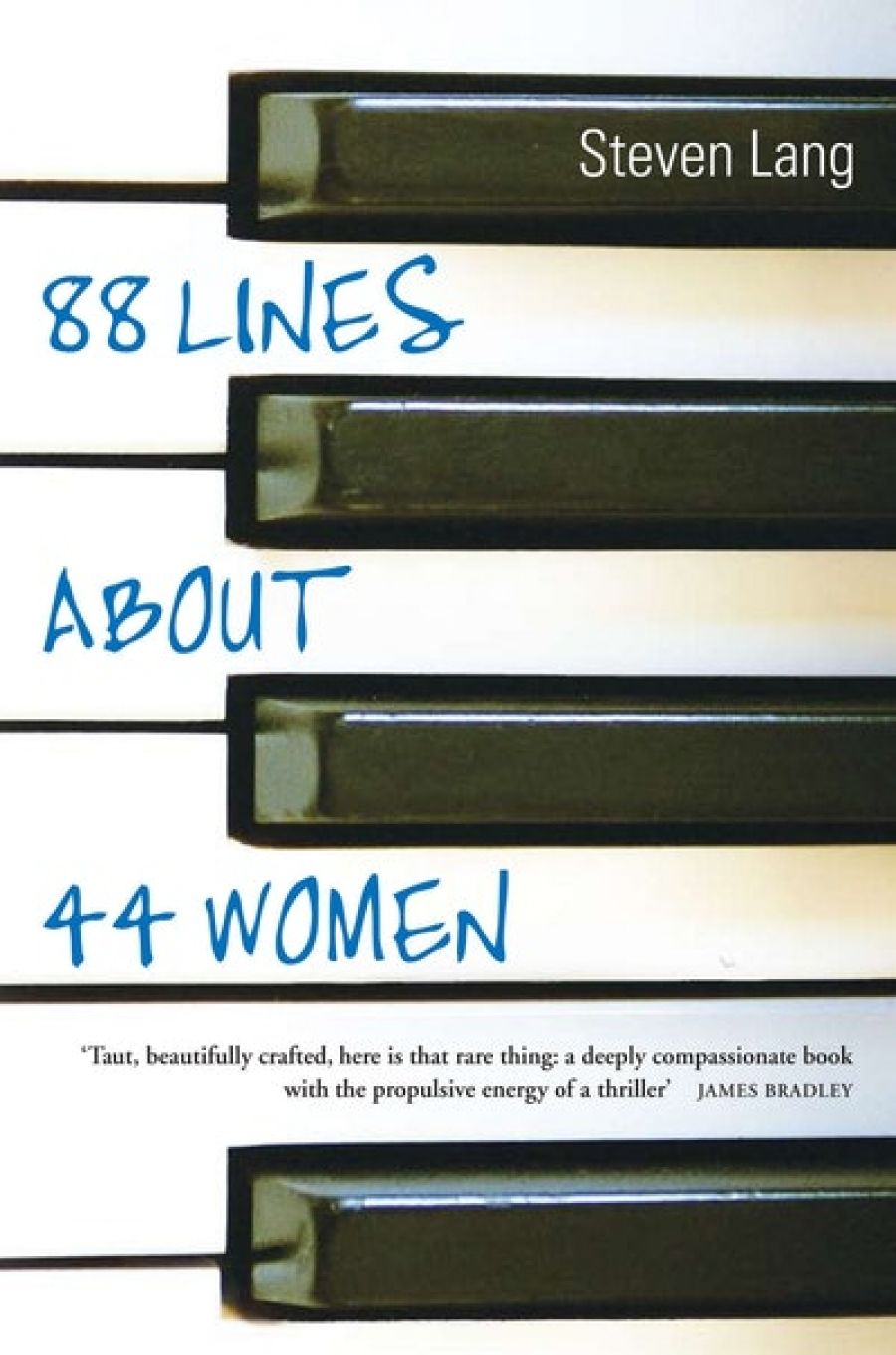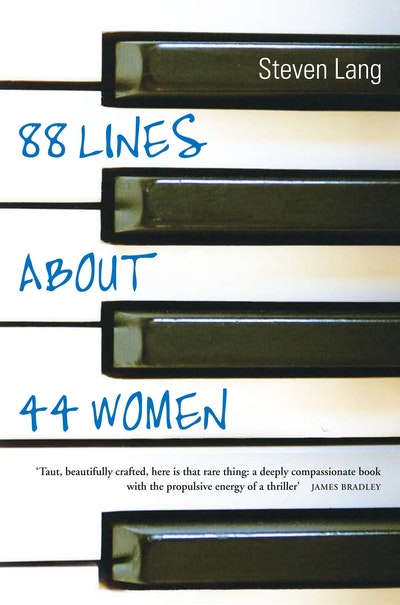
- Free Article: No
- Contents Category: Fiction
- Review Article: Yes
- Article Title: Emotionally bonsai’d
- Online Only: No
- Custom Highlight Text:
In an intriguing coincidence, three recent novels by notable male writers feature central characters who, former members of world-famous rock bands, ruminate on the mess they made of the past. The notion of faded rock stars clearly provides much scope for exploring issues of male ego, sexuality and mid-life crisis. Unlike Nick Hornby (Juliet Naked) and Nick Earls (The Story of Butterfish), Steven Lang is no ‘lad-lit’ writer, though he does delve into similar thematic territory in his second novel, 88 Lines About 44 Women.
- Book 1 Title: 88 Lines About 44 Women
- Book 1 Biblio: Viking, $32.95 pb, 258 pp
- Book 1 Cover Small (400 x 600):

Keyboard player Lawrence Martin was once a member of a successful rock band, one half of its songwriting team, who attained the kind of fame that brings endless money, sex and attention. Eighteen years have elapsed since the boat accident that killed his glamorous soap-star wife, Gizelle. Following a sharp reminder of the past, Lawrence has instinctively fled from Bangalow, New South Wales, to the wilds of Scotland where he lives in self-imposed exile, conducting ‘a long experiment in serial monogamy’. Then his former songwriting partner and boarding-school ally Roly contacts him. This triggers further reflections on their shared past, and jeopardises Lawrence’s fledgling relationship with local beauty Sam.
On the surface, this is a literary thriller, the narrative shaped and driven in pursuit of an answer to the question: what really happened the day Gizelle died? The novel opens with an account of the fatal accident, told through the narrator’s eyes, yet by page thirteen we are subtly invited to question its veracity, as Lawrence ponders his reluctance to tell Sam ‘that story, that confection, refined as it is by years of repetition’. Thus, Lang cleverly puts the reader on alert, signalling that we are dealing with an unreliable narrator, a repressed boarding-school survivor who has been taught from a young age to distance himself from his emotions. Decoding the truth about Lawrence is compounded by the fact that he is constantly masking his true feelings and motivations from himself. Many of the clues to his character are leaked through observations and complaints from the women in his life.
At its core, this is a novel about the emotional lives of men, both confronting and contradicting the usual clichés about men and sex, men and intimacy, and about their limited ability to talk about their feelings. Lawrence’s sister offhandedly refers to boarding-school boys like him as ‘relationally autistic’. His lovers complain about his coldness, his repression. His inability to speak, to express his thoughts and feelings, is a recurring motif. (‘This was one of the things about Roly and me,’ he reflects, ‘the freedom to speak’.) While, ostensibly, Lawrence is an archetypal unfeeling male, the reader is introduced to the underside of that cliché, allowed to explore his hidden emotional life and trace its formation.
Lang displayed an impressive affinity for evoking landscape and setting in his first novel, An Accidental Terrorist (2005), set in Australia’s old-growth forests, and this is evident again here. The past and present respectively belong to two distinct settings: the intense, sultry heat and showy splendour of Sydney during Lawrence’s years of hedonistic success with his band; and the austere beauty and bone-chilling cold of Scotland’s sparsely populated north. These settings both mirror and chart the emotional landscape of the novel, illustrative details complementing rather than intruding on the story. One image in particular, of trees ‘bonsai’d by the cold’, seems to encapsulate Lawrence’s emotional state, and the role played by his distant parents and boarding-school childhood in stunting his emotional development.
Lawrence ruminates that unexpressed thoughts ‘have ramifications; they swell out into the world, it doesn’t matter how you try to temper them’. At his best, these feelings are translated into music. There are some beautiful passages about the creative process, describing the genesis of a song or a piece in ‘a mood, a feeling of sound’ and defining success as the ability, after a process of ‘twisting sound into shapes’, to convey ‘the mood ... first felt’ to a listener. Lang also writes perceptively about the risk inherent in the creative process, similar to the risk in exposing oneself in a relationship – ‘the danger of reaching too high’. Most of the intimate connections in this book are wordless, either through song or through sex. Lawrence observes of sex that, ‘if it’s good, there’s rarely anything casual about it at all’. Sex, like music, is an expression of mood and feeling that doesn’t require words.
This is an excellent novel; a finely calibrated blend of a carefully paced thriller and a literary exploration of masculinity. Lawrence is a wonderfully nuanced narrator, both the ‘good man’ Sam assures him he is and the relational ‘tight-ass’ a former girlfriend calls him. And while some of the other characters in the book seem two-dimensional, there are glimmers of understanding and empathy for even the most unlikeable. Lawrence warns us of his bias: ‘I have a way of painting my lovers in an unkind light when I’m not in the room with them.’


Comments powered by CComment